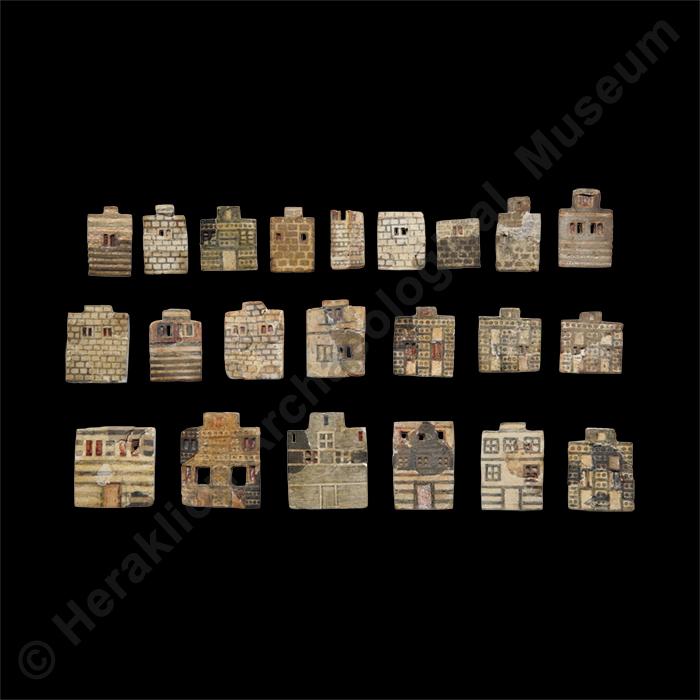The "Town Mosaic". Plaques with house façades and natural landscape originally decorating a wooden object
Υ1
Faience
Many plaques are preserved intact, while some are incomplete and restored
Height from 2.7 to 5 cm.
Knossos
Palace, East Wing
Middle Bronze Age. Neopalatial period, Middle Minoan ΙΙΒ- ΙΙΙ period:
1700-1600 BC:
Gallery:
IVCase:
37Exhibition thematic unit:
Late Bronze Age - Neopalatial period (1700-1450 BC). The New Palaces. The zenith of Minoan civilisationThe Minoan world. Architecture
Description
A set of approximately 100 painted faience plaques, all found in the same area of the East Wing of the palace of Knossos, was identified by Evans as forming a unified composition that probably decorated a piece of wooden furniture or a tableau. Most of the plaques depict house façades, while there are also floral motifs, animals, human figures in various attitudes, military equipment and a seascape. The houses, forming an entire city, vary in size and construction. The larger ones would have been placed in the foreground and the smaller in the background of the scene, giving an impression of perspective. The buildings are two or three storeys high with flat roofs, staircases leading to the upper floor, various types of window and semi-enclosed spaces. Different construction methods are visible, using ashlar blocks, rubble or brick. Round wooden beams, their ends represented by solid circles on the exterior masonry, ensured the elasticity of the walls in case of earthquake. From an architectural point of view, the “Town Mosaic” provides us with valuable information on the building methods and layout of Minoan houses, while from a technical and technological point of view it is a unique masterpiece of Minoan art. As regards the interpretation of the scene, the human figures and weaponry led Evans to suppose that it represents a besieged city, resembling that depicted on the “Siege Rhyton” from Mycenae. A similar scene also appears in the West House Frieze from Thera.Bibliography:
A.J. Evans, The Palace of Minos: A Comparative Account of the Successive Stages of the Early Cretan Civilization as Illustrated by the Discoveries at Knossos, 4 vols., London 1921-1935, Vol. I, 301-314. C. Palyvou, "Architecture in Aegean Bronze Age Art: Facades with no Interiors", L. Morgan (ed.), Aegean Wall Painting. A Tribute to Mark Cameron, British School at Athens Studies 13, London 2005, 185-197. K. Athanasaki, Catalogue of the Exhibition A Journey to the Land of Immortals: Treasures of Ancient Greece, Tokyo National Museum, Nagasaki Prefectural Art Museum, Kobe City Museum, June 2016-April 2017, cat. no. 43.Author:
S. M.Photographs' metadata
